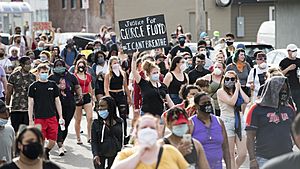George Floyd protests in Minneapolis–Saint Paul facts for kids
Quick facts for kids George Floyd protestsin Minneapolis–Saint Paul |
|
|---|---|
| Part of George Floyd protests | |
|
Clockwise from top
|
|
| Date | May 26, 2020 – ongoing (4 years, 9 months, 2 weeks and 2 days) |
| Location | |
| Caused by |
|
| Goals |
|
| Methods | Mass demonstrations, civil disobedience, civil resistance, riots, arson, public art |
| Status | Prolonged local unrest |
| Aftermath | |
| Death(s) |
|
| Arrested | 604 from May 27, 2020—June 2, 2020 |
| Charged |
|
Local protests over the murder of George Floyd (sometimes called the Minneapolis riots or Minneapolis uprising) began on May 26, 2020, and quickly inspired a global protest movement against police brutality and racial inequality. The initial events were a reaction to a video filmed the day before and circulated widely in the media of police officer Derek Chauvin kneeling on Floyd's neck for 9 minutes and 29 seconds while Floyd struggled to breathe, begged for help, lost consciousness, and died. Public outrage over the content of the video gave way to widespread civil disorder in Minneapolis, Saint Paul, and other cities in the Minneapolis–Saint Paul metropolitan area over a three-night period from May 27–29, 2020.
In the days after Floyd's murder, Minneapolis sustained extraordinary damage from rioting and looting in the resulting chaos—largely concentrated on a 5-mile (8.0 km) stretch of Lake Street south of downtown—including the demise of the city's third police precinct building, which was overrun by demonstrators and set on fire. At cost of $350 million, approximately 1,300 properties in Minneapolis were damaged by the civil unrest, of which nearly 100 were entirely destroyed. Saint Paul suffered damages that totaled $82 million and affected 330 buildings, including 37 that were heavily damaged or entirely destroyed, mostly along the its University Avenue business corridor.
Governor Tim Walz activated the Minnesota National Guard in response to civil unrest. The 7,123 troops pressed into duty represented the largest deployment of the state's forces since World War II. By early June 2020, violence in the Minneapolis–Saint Paul metropolitan area had resulted in at least 2 deaths, 604 arrests, and upwards of $500 million in damage to approximately 1,500 properties, the second-most destructive period of local unrest in United States history, after the 1992 Los Angeles riots. Violent protests in Minneapolis–Saint Paul over the murder of George Floyd largely subsided after May 30, 2020. The Minnesota National Guard and a multi-jurisdiction government command that responded to the riots demobilized on June 7, 2020.
Local protests and unrest over Floyd's murder continued in 2020—2022 and broadened to other issues of racial injustice.






